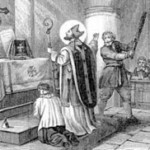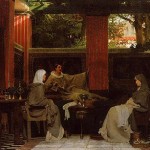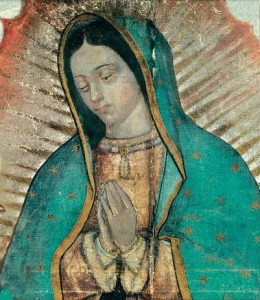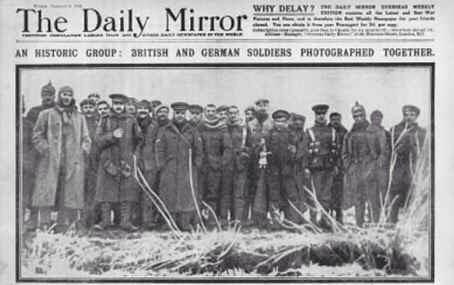Quick shout-out to Saint Venantius Fortunatus, a poet and Bishop of the early Church who died in 610. He was a big fan of Saint Martin of Tours, one of the greatest military saints (as are we). A bit of a wandering minstrel, St. Venantius went out of his way to visit the shrine of St. Martin on his travels and eventually wrote a book about him called Vita S. Martini. It is a long narrative poem, reminiscent of the classical epics of Greek and Roman cultures but replete with Christian references and allusions, depicting the life of Saint Martin. We hope Venantius told the whole story!
Monthly Archives: December 2013
Just War and Just Peace
In 1932 as conflicts were worsening in Asia and Hitler was seizing power in Germany, two prominent theologians, H. Richard Niebuhr of Yale University and his brother Reinhold Niebuhr of Union Theological Seminary in New York, debated in the pages of Christian Century whether U.S. military intervention would be a “just” or “unjust” war. The United Church of Christ Office of General Ministries has provided the original text of the debate at their website: “We present these papers because they are relevant to the international debate over terrorism and the use of armed force in self-defense.” Here is an overview of what you will find there:
1. Radical trust in God: H. Richard Niebuhr argues that radical obedience to God requires Christian nonviolence. Any other response would mean distrust in God and God’s promises. 2. No absolutes: In a fallen world, Reinhold Niebuhr replies, Christians cannot act as if the reign of God has already been established, and must sometimes use force to protect the innocent. 3, A final word In a letter to the editors of Christian Century, H. Richard Niebuhr sums up the debate. 4. Turning to Tradition In making moral judgments about the war in Iraq, says UCC theologian Susan Brooks Thistlethwaite, Christians can find help from a “1,500-year-old tradition.” 5. Just Peace The “Just Peace” doctrine commended by the UCC’s General Synod in 1985 is distinct both from “just war” theory and traditional Christian pacifism.
St. Jucundus and St. Nicasius, Dec. 14
Recently, Christian pastors in Kenya have been asking for AK-47s to defend themselves and their churches from Islamic extremists.

Rev. Peter Karanja (center), of the National Council of Churches of Kenya, addresses a news conference on Wednesday, Oct 30. He said the government should see this as writing on the wall and that Kenyans are getting tired of the continuing insecurity. (Fredrick Nzwili/RNS)
“’Our many churches are not under any protection. They do not have walls or gates. The government should issue AK-47 rifles to every church so that we can stop them from being burnt, our property from being looted and our pastors and Christians from being killed,’ said Lambert Mbela, a pastor at Mathole’s church.”
It is interesting to contemplate the examples of St. Nicasius and St. Jucundus (from Catholic.org):
An army of barbarians ravaging part of Gaul plundered the city of Rheims. Nicasius, the Bishop, had foretold this calamity to his flock in consequence of a vision, and urged them to prepare for the visitation by works of penance. When he saw the enemy at the gates and in the streets, forgetting himself and solicitous only for his spiritual children, he went from door to door encouraging all to patience and constancy. When the people asked him whether they should yield or fight to the end he, knowing that the city must fall, replied, “Let us abide the mercy of God and pray for our enemies. I am ready to give myself for my people.” Standing at  the door of his church, in endeavoring to save the lives of some, he exposed himself to the swords of the infidels, who cut off his head. St. Florentius, his deacon, and St. Jucundus, his lector, were massacred by his side. His sister, St. Eutropia, seeing herself spared in order that hers might be another fate, threw herself upon her brother’s murderer and kicked and scratched him till she too was cut down and killed.
the door of his church, in endeavoring to save the lives of some, he exposed himself to the swords of the infidels, who cut off his head. St. Florentius, his deacon, and St. Jucundus, his lector, were massacred by his side. His sister, St. Eutropia, seeing herself spared in order that hers might be another fate, threw herself upon her brother’s murderer and kicked and scratched him till she too was cut down and killed.
Race, Jesus, Santa, Mary
This week on Fox News Megan Kelly insisted that both Santa and Jesus are (or were) white. I thought it was interesting that this latest race kerfuffle coincided with the Feast Day of Our Lady of Guadalupe (December 12 in the US). This from Catholic.org:
“When we reflect on the feast of Our Lady of Guadalupe we learn two important lessons, one of faith and one of understanding. Missionaries who first came to Mexico with the conquistadors had little success in the beginning. After nearly a generation, only a few hundred Native Mexicans had converted to the Christian faith. Whether they simply did not understand what the missionaries had to offer or whether they resented these people who made them slaves, Christianity was not popular among the native people.
Then in 1531 miracles began to happen. Jesus’ own mother appeared to humble Juan Diego. The signs — of the roses, of the uncle miraculously cured of a deadly illness, and especially of her beautiful image on Juan’s mantle — convinced the people there was something to be considered in Christianity. Within a short time, six million Native Mexicans had themselves baptized as Christians.
The first lesson is that God has chosen Mary to lead us to Jesus. No matter what critics may say of the devotion of Mexicans (and Mexican descendants) to Our Lady of Guadalupe, they owe their Christianity to her influence. If it were not for her, they would not know her son, and so they are eternally grateful. The second lesson we take from Mary herself. Mary appeared to Juan Diego not as a European madonna but as a beautiful Aztec princess speaking to him in his own Aztec language. If we want to help someone appreciate the gospel we bring, we must appreciate the culture and the mentality in which they live their lives. By understanding them, we can help them to understand and know Christ. Our Lady of Guadalupe is patron of the Americas.”
I only bring this up here because we cannot deny a connection between militarism and ideas of white superiority, or American superiority, or the idea that the lives of certain people are more valuable than the lives of others. I am not calling Megan Kelly a racist! If I had to speak on live television and be constantly recorded, I’m sure I’d get caught saying some things I didn’t mean or didn’t mean in a certain way, too. I am simply pointing out that her comments betray certain assumptions or ingrained ways of thinking, often unexamined, which Mary, when she appeared to Juan Diego, definitely undermined!
St. Lucy, Dec. 13
From the website of St. Lucy’s Church in the diocese of Scranton (abridged):
The story of St. Lucy is connected with a period of great political uncertainly and anxiety in the Roman Empire. After 400 years, the Roman Empire was declining under the constant onslaught of its enemies. Diocletian became the Emperor in 284 and set about trying to regain Rome’s former power and glory. It was into this time that Lucy was born into a rich and noble Roman family about the year 283 in Syracuse, Sicily. Lucy raised a devout Catholic and privately decided in her teenage years to consecrate her virginity to God and devote her worldly goods to the service of the poor. However, her mother, not knowing of Lucy’s promise and suffering from a bleeding disorder feared for Lucy’s future. She arranged Lucy’s marriage to a young man of a wealthy pagan family.
Not far away was the shrine of the famous virgin-martyr Agatha, who had been executed in the Decian persecution (5 Feb. 251 A.D.). St. Agatha came to Lucy in a dream and told her that because of her faith her mother would be cured. Agatha also told Lucy that God would do great things through her. Eutychia was in fact cured. Joyful at her cure, Lucy’s mother agreed to let Lucy help the poor and for now not marry. As Lucy’s reputation grew in Syracuse, the clouds of persecution gathered over Sicily. Lucy was renowned for her beauty and her sparkling eyes. It was said she had a radiance about her that came from her love for Christ.
Meanwhile, at the imperial palace in Rome, Diocletian realized that the empire was now too unwieldy and too exposed. To better manage the empire he split the Empire into three parts with himself as Augustus Caesar (or head Caesar). General Galerius was appointed Caesar in the East and General Maximian as Caesar in the West. They would report to Diocletian. Diocletian at first was very tolerant of the Catholic Faith. However, as the Empire reeled under the continued attacks of its many enemies, Galerius and Maximian persuaded Diocletian to attempt to reinstate the ancient pagan religion throughout the empire. It was thought that this would unify and strengthen the empire as in centuries past.
In 303 A.D, Diocletian issued three edicts that began the last and worst of the persecutions against the Catholic Faith. The first ordered the destruction of the churches and the burning of all Catholic writings, especially the Bible. The second edict was directed against the clergy. Great numbers of bishops, priests and deacons were arrested and martyred. Others were sold off as slaves in the salt and copper mines. The third edict was directed at the laity. Villages and towns would be leveled and their inhabitants slaughtered or sold into slavery for being Catholic.
In 304 A.D. the frightful persecution came to Sicily. The Roman governor, Pascasio, probably to court favor with the emperor, was determined to carry out the three decrees with the full weight of the Roman Army behind him.
With the persecution in full swing, Lucy had now to help the poor and her fellow Catholics who had taken refuge in the extensive catacombs underneath Syracuse. Lucy had become well known in Syracuse for her faith and charitable works. In these sorrowful days Lucy carried food and drink to Catholics hiding in the dark underground catacombs. It is said she wore a wreath on her head with candles to light her way because her arms were full of food and water. Word of her heroic deeds spread and did not escape the ears of informants. It was the pagan youth to whom Lucy had been betrothed, motivated by pride, greed, jealousy or a combination of all three, who in his anger he denounced Lucy to Pascasio, the governor, as a Christian. Lucy was now caught up in the great persecution of Diocletian. Her patrician status could no longer save her.
Pascasio seized this opportunity to make Lucy an example of Rome’s greatness and displeasure. Thus, the governor wanted to destroy the beautiful “light” that was Lucy. He was not content to just kill Lucy’s body. Lucy had radiance about her, both physically and spiritually. It was his intent to show the Catholics of Syracuse that the Roman Empire was greater than their God. Lucy’s public humiliation was designed to discredit the power of Christ and His Church. And so Lucy, a beautiful young woman, noted for her eyes that shined with a glow of inner beauty and goodness was hauled before the governor. Lucy would be forced to renounce her faith and worship the pagan gods. If Lucy could be forced to renounce her faith, than other Catholics would follow suit.
Pascasio order a public spectacle in the magnificent amphitheater of Syracuse. Looking down on the helpless Lucy was the governor sitting in the royal box, surrounded by politician and generals in their splendid Roman armor and vibrant red clocks. The might of Rome pitted against Lucy.
The governor’s plan was to plunge Lucy into the darkness and degradation of sin. She was first condemned to suffer the shame of prostitution; but when the soldiers came take her to a brothel, in the strength of God, she stood immovable. No matter how they tried, they could not drag her away to that place of shame. In a desperate effort, a team of oxen was used, but to no avail. Frustrated, the governor demanded of Lucy, “How are you doing this?” Lucy could only respond that it was not she, but Jesus Christ.
Infuriated, he governor then ordered Lucy to be burned alive if she didn’t deny Jesus and worship the pagan gods. Lucy refused. Bundles of twigs were placed around her. When the soldiers tried to ignite the bundles, they would not burn. The governor ordered the wood to be soaked with oil, but the oil would not ignite. When asked how she was doing all this, Lucy could only answer once again that it was not her but the power of Jesus Christ. The pagans in the crowd were being won over by this hapless girl.
Sensing that his demonstration of Roman might was becoming undone, in desperation, Pascasio ordered Lucy’s eyes to be gouged out. Still, Lucy refused to deny Christ. Then Pascasio ordered a soldier to stab Lucy in the neck with his sword. She won her crown of martyrdom on December 13, 304.
In death, Lucy became an even greater example of Christian witness. Miracles started immediately. Lucy was carried to the cemetery and in Roman tradition her body was prepared for burial in the family mausoleum. Here, they discovered that her eyes had been miraculously restored. To mark this miracle, Lucy is often pictured with a dish on which is a set of eyes. She also hold the palm branch, symbol of victory over evil.
Joyeux Noel (2005)
Be sure to follow Veterans for Peace if you’re on Twitter! They reminded us about this wonderful moment in history:
#vets4peace remembers the #ChristmasTruce of #1914, when German and British soldiers refused to fight. #peacepic.twitter.com/EMyqwDM6VZ
— Veterans For Peace (@VFPNational) December 12, 2013
This Christmas, be sure to watch Joyeaux Noel (2005): On Christmas Eve during world War I, the Germans, French, and Scottish fraternize and get to know the men who live on the opposite side of a brutal war, in what became a true lesson of humanity.
Catholics Missing the Point
What Catholics Missed in The Hunger Games, an article by a CAM co-founder
“The respect Collins paid her young readers in writing this trilogy was to see
them as not only conscious, but socially conscious, and potentially
curious about or concerned with that central human problem called war. It was
interesting to see that Christian adults saw very little about the central human
problem of war in this wildly popular film that was, in the words of its Roman
Catholic author, written about war, and after a decade of living under a
government that is perpetually waging war.”
Pope Francis World Day of Peace
Pope Francis has just issued his message for World Day of Peace on Jan. 1.
“All who accept the life of Christ and live in him acknowledge God as Father and give themselves completely to him, loving him above all things. The reconciled person sees in God the Father of all, and, as a consequence, is spurred on to live a life of fraternity open to all. In Christ, the other is welcomed and loved as a son or daughter of God, as a brother or sister, not as a stranger, much less as a rival or even an enemy. In God’s family, where all are sons and daughters of the same Father, and, because they are grafted to Christ, sons and daughters in the Son, there are no “disposable lives”. All men and women enjoy an equal and inviolable dignity. All are loved by God. All have been redeemed by the blood of Christ, who died on the Cross and rose for all. This is the reason why no one can remain indifferent before the lot of our brothers and sisters.”
The Real Situation
I heard a cover of this tonight. It was awesome. For your Thursday…
Real situation
Album: Uprising (1980)
Lyrics:
Check out the real situation,
Nation war against nation,
Where did it all begin, when will it end..
Well it seems like, total destruction,
The only solution.
And there ain’t no use,
No one can stop them now,
Ain’t no use, nobody can stop them now.
Give them an inch, they take a.. yard.
Give them yard they take a mile,
Once a man and twice a child,
And everything is just for a while.
It seems like, total destruction,
The only solution.
And there ain’t no use,
No one can stop them now.
Ain’t no use no one can stop them now.
Ain’t no use no one can stop them now.
Ain’t no use no one can stop them now.
Check in the real situation,
Check it out, check it out,
Nation fight against nation,
Where did it all begin, where will it end.
Well it seems like total destruction,
The only solution.
No use can’t stop them,
Ain’t no use can’t stop them,
Ain’t no use no one can’t stop them now.
Can’t stop them now. (no one can stop them now)
Ain’t no use no one can stop them now.
Ain’t no use you even try.
Ain’t no use got to say bye bye.
Ain’t no use no one can stop them now.
No one can stop them now…













![No War Toys at Christmas [03]](https://catholicsagainstmilitarism.com/wp-content/uploads/2013/12/No-War-Toys-at-Christmas-03.jpg)